He goes to school, plays sports year-round, and hangs out with friends. He’s a busy kid. But many kids are busy. What makes Simon so interesting is the boundlessness of his busyness. He’s adventurous and refined—one moment he’s glancing headers off his noggin on the soccer field, the next he’s plucking jazz scales on an upright bass. Consider the chutzpah of choosing an upright over a guitar at twelve years old. To be that self-assured at so young an age.
To feel boundless.
What adult wouldn’t envy that? Even just a little?
With the sixth grade now behind him, and summer ahead, Simon has wiggle room in his ordinarily hectic schedule to pursue some of his other hobbies—running being chief among them. Last weekend, Simon finished his first half-marathon, taking top honors in his age group. In April, he paced his mother, Naomi, as she ran 50 miles at the Potawatomi Trail Races.
In this interview, Simon talks about his experience at Potawatomi, his favorite aid station snacks (one of which might just blow your mind!), and whether he intends to return to run it again.
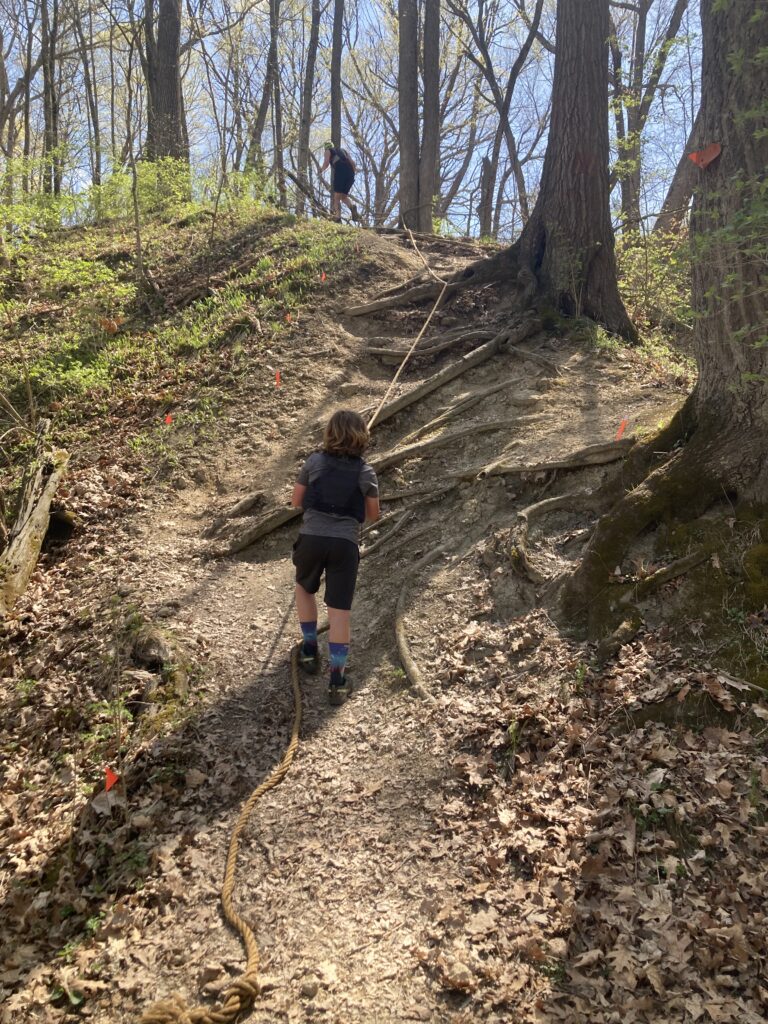
What is the story behind pacing your mom at Potawatomi?
My family and I like going on hikes together. After a couple of years of hiking, I ran Galena (Sky Races). Last year I saw my mom run at Potawatomi and I wanted to try it out.
What were your first impressions of the course when you visited it prior to the race?
The first mile felt great. After three miles, it got a lot harder.
Were you nervous before the race?
No. I checked out the course beforehand, and saw my mom run it last year. I didn’t get a chance to train before the race. I was sick for a week, then my asthma kept me from doing any running. My mom helped me get my vest ready the day before. My dad thought I was starting at loop four, so when my mom got me at loop three, I was thrown into the race and didn’t have time to get nervous.
How was your experience on race day? Was there a section of the course that you enjoyed? Or perhaps a section that you disliked?
I liked going through the creek. It woke me up a bit, the cool water. The hills after it really sucked though. I felt very heavy and weighed down from the water. The people cheering me on while I was on the course helped me get through the race.
What was the hardest thing about Potawatomi for you?
The elevation: going up and down, that hurt.
Do you have a favorite aid station snack?
I like having Warheads with me. They're sour and perked me up. Another favorite is Harvest Cheddar Sun Chips.
How did you celebrate after your incredible performance?
I went back to the hotel with my siblings and dad, and we went swimming.
Would you do it again?
Yes! If there was a 15 mile option, I’d do that. Maybe 30?
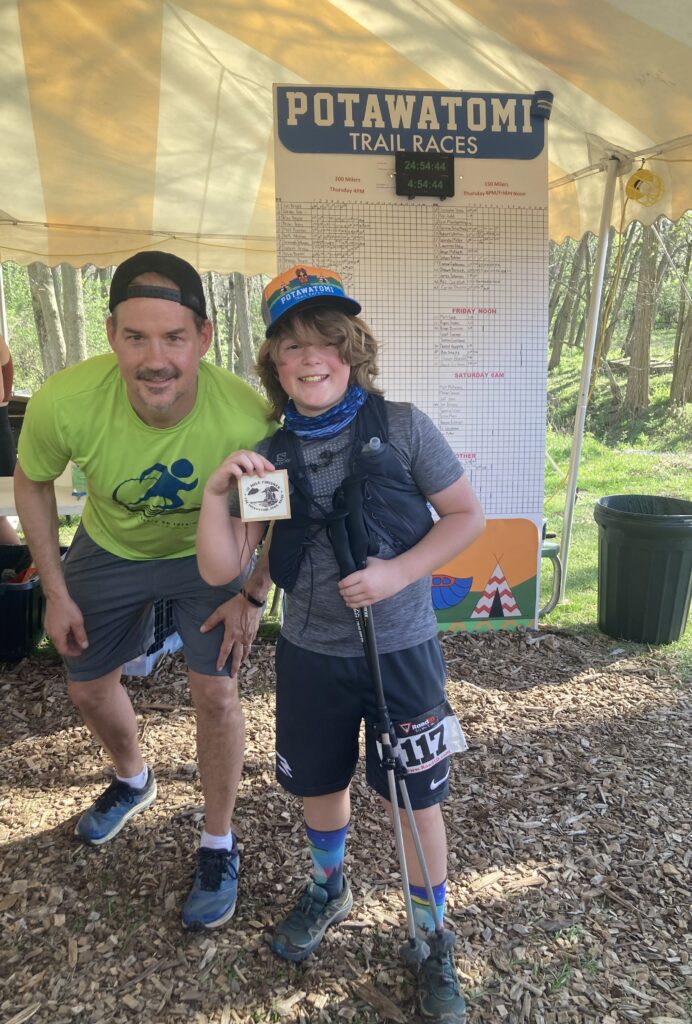
Photos provided by Naomi Copeland
Raised forty miles west of Chicago, in suburban Naperville, Kirk settled in Indiana after graduating from Ohio State University. Having grown up a wrestler, Kirk came to trail running through obstacle course racing and an appreciation for Billy Yang’s films, particularly Life in a Day. In 2022, Kirk turned his attention to race directing.
Here, Kirk shares what compels him to run, why he started Trailblazer Running Company, and a truly unique race idea that he calls “Trail Golf.”
* * *
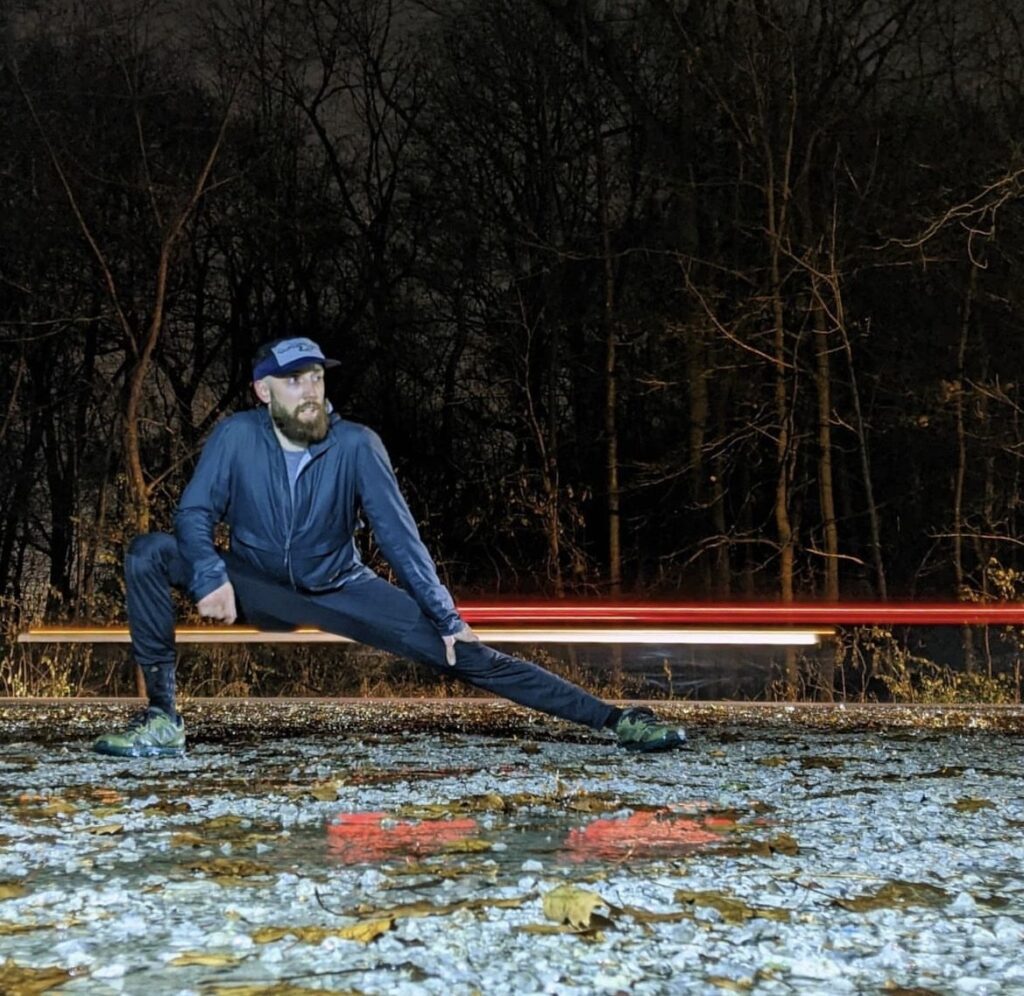
How did running become part of your life?
I wasn’t much of a runner growing up. In high school, wrestling was my main sport. But I went to college at Ohio State and on the day I was set to graduate, my brother convinced me to do a Spartan race with him. We didn’t have any idea how long it would take. The race was three and a half miles, and it ended up taking us a ridiculously long time. I was almost late for graduation. But we did it and I remember it being so hard. Fast forward a few years; I had moved to Indiana. The company I worked for offered free sponsorship entry into the Chicago Marathon. One of my co-workers suggested I sign up. He was an ultra-runner, and he’d tell me all his running stories. It sounded like something I wanted to do, so I signed up. Training for the marathon—getting out there every day, getting into a run—I fell in love with the process. I felt better on days when I ran. I felt like a better person. Trail running came about through watching Billy Yang and the Ginger Runner videos. I fell into a rabbit hole watching their films and became totally in love with the sport and culture. It spoke to me.
What's the story behind Trailblazer Running Company?
I’ve always liked organizing events. My father-in-law organizes big softball tournaments in the Midwest and I’ve worked with him a couple times, directing at different sites. When I was more into wrestling I aspired to put on tournaments. It never happened though. So it was only natural when I discovered trail running that I’d think to put on a race. It aligned what I was doing in my free time with what I gravitate towards in a professional sense. In early 2020, I came up with some ideas for trail races. I reached out to the park district hoping to organize an event, then Covid came. So I didn’t do anything with the race for a while; I just put it on the backburner. Eventually, the first race I put on was False Spring. It was last year, in March of 2022. There were seventy-five sign-ups. Sixty-some showed up on race day. It was forty degrees and drizzling, but they all had a great time. I learned a lot directing that race. So, the following August I put on Oakadoke. There were over a hundred sign-ups for that. Hopefully it’ll grow from there.
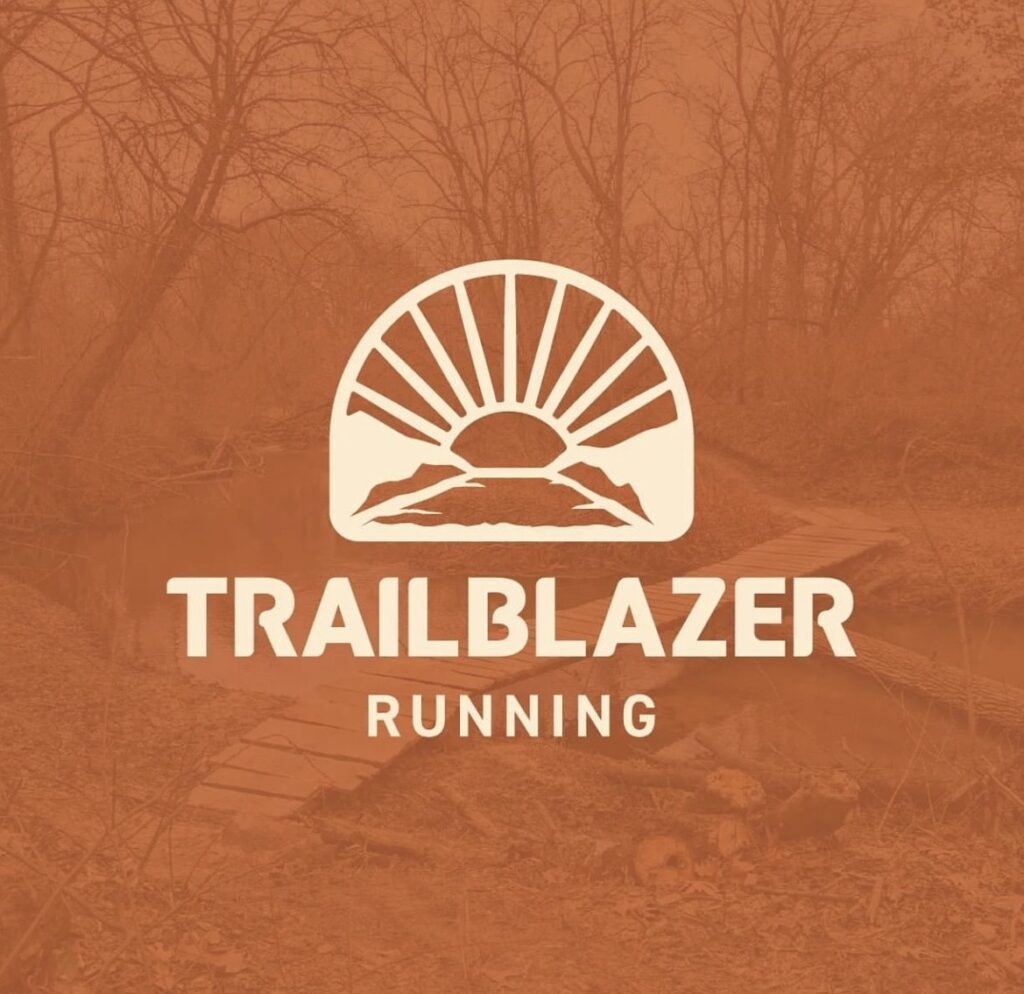
Are you signed up for any races this year?
The only thing on my calendar is a 100-miler: the No Business 100 in Tennessee, in October. It’s a big loop that traverses through northeast Tennessee and cuts into Kentucky for a bit. Looking at pictures of it, that’s a 100-miler I’m really excited to do. Not because it’s easy, but because it looks difficult and beautiful.
What compels you to run a race like No Business 100?
It’s a mixture of a few things. It’s the possibility that I might go through a rollercoaster of emotions by doing something difficult and come out the other side a changed person, an improved person. I want to be more humble and better able to deal with challenges in life, that’s why I go and do these races. I also love being out in nature, exploring and connecting with it. I was recently in Arizona. The runs I did weren’t necessarily training runs. I was going out there to explore and run mountains. I’d go up a mountain, see more trails, and run towards them. I was blown away by how beautiful it is out there. I love having those experiences. Another reason I do these runs is I want to be a superhero to my kids. Being able to show them all the hard things I’ve done, all the cool places I’ve been—that motivates me a lot when I’m feeling down in a race. I want to seem invincible to them, though I know that’s always not realistic.

What’s next for Trailblazer Running Company?
I’d really like to do something at the Indiana Dunes. I’ve been told that it’s hard to do because of all the permitting; however, I have reached out to someone who is in charge of permitting and pitched him the idea of doing a 50k. He did say it would be difficult to get all the permitting done, that it would be a long process, but he also said to come back to him with a plan and that we’d talk. He sounded kind of excited about it. So I am going to put a plan in place and we’ll see. I also have an idea for a race I call “Trail Golf.” I might turn it into a fun-run this year to prove out the concept. How it works is, at the start of each hour, everyone runs a three to four mile loop on a trail. Depending on the time window that you finish in, you get a stroke score. A birdie, a bogey, a double-bogey, and so on. It will be 9 loops—or holes—each one being a different route. The winner would be who had the lowest overall score. I was thinking about doing it where we run Oakadoke. I have a lot of the logistics figured out, I just have to put together the promotional stuff and confirm a day with the park district. I wanted to do it at the end of June or July. It’d be a no frills event. I just want to see what people think of it and how it goes. If someone’s looking to do an ultra for the first time, it might be a cool way to do it.
Photos provided by Kirk Cherep @kirkcherep @trailblazer.running
Barely larger than two square miles, it serves as the seat of Johnson County, with a population just north of 1,300. Otherwise modest and unassuming, Vienna is home to one of the most storied events in ultrarunning—Tunnel Hill.
Since its inception in 2014, Tunnel Hill has attracted a who’s who of elite runners: Coree Woltering, Harvey Lewis, Arlen Glick, Traci Falbo, Zach Bitter, and Camille Herron, to name a few. It’s an undeniably fast course. Records fall here like dominos.
Race Director Steve Durbin has seen some remarkable things in this quiet Illinois town—things he never dreamed of seeing—and he shares some of those stories here, recounting Zach’s and Camille’s record-breaking performances and the pivotal moment that made all of it possible.
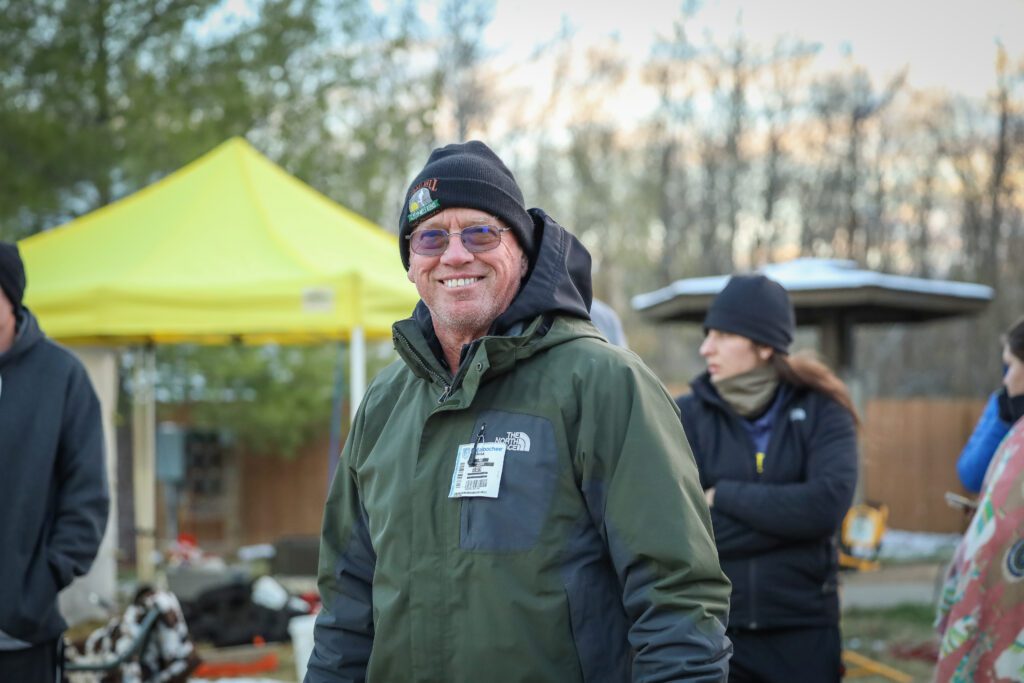
Tunnel Hill is a notoriously fast course. Is that by design?
Yes. Definitely. We wanted the course to be as fast as we could make it, yet still, be a beautiful and interesting course. The years leading up to 2014 saw lots of courses claiming to be the toughest, with the most elevation change. We felt there was a market for a race that allowed for people to run fast. An “easier” course for those wishing to run their first 100, or 50, or for veterans of the distance to run a personal best. If you remember all the tough mudders back before 2014, everyone was trying to be Barkley-esque. “This is the toughest course anywhere.” “My course is tougher than yours.” We went for the opposite of that. Our slogan was, and continues to be “How fast do you want to run?” Rails-to-Trails courses can be boring, so we use the prettiest 25 miles of the 56 total miles of the Tunnel Hill State Trail. You’ll see wetlands, lots of trestles, rock formations, and of course the famous tunnel. Yet the course is relatively flat and smooth.
What were the first few years like?
We weren’t sure what to expect the first year, 2014. We were hoping for at least 50 runners. Over 300 registered. The week leading up to the race, it was 70 degrees on that Thursday. Enter the “polar vortex”. By race morning it was 18 degrees. 48-hour world record holder, Traci Falbo, ran an FKT for 100 trail miles with her 14:45. That gave us immediate credibility. Everyone knew Traci. In 2015, Mike Bialick came down from Minnesota and ran 12:52, which was the fastest 100 in North America by about 45 minutes. Other runners were looking at Ultra Running Magazine’s top 100 runners and wondering, “Where is this Tunnel Hill?” The best decision we made was to certify the course distance. That’s what caught Camille Herron’s eye.
Were you aware of Camille Herron prior to 2017?
I really didn’t keep up with the ultra-running elites. I had a keen interest in Western States (two-time failure there), so I knew of Scott Jurek. I enjoyed running trail races. But since I mostly ran regional races, I only knew a handful of the elites. So, no, I didn’t know Camille. Her husband/coach, Conner Holt, emailed me about two weeks prior to the race, asking about her running it. He sent her resume to me, and I was like “Holy crap!” First American to win Comrades in a million years, and holder of several records.
Is it common for an athlete to reach out beforehand and make it known that they are going for a world record?
It is now, but it wasn’t back then. I had no idea someone would set a legit world record on our course. After the contact with Conor, we took a LOT of steps to make sure everything was legit for a world record. Special thanks to timer/USATF official/course certifier, Brandon Wilson, for his work in getting us ready. Before the race Camille was on Facebook proclaiming “I was born with wings and legs of steel. I am going to break the world record at Tunnel Hill.” And I’m thinking, “God, I sure hope so.” As we all know, she shattered the world record by 63 minutes, with a brilliant 12:42:20.
So what about when Zach Bitter comes the following year?
I knew of Zach from seeing him race around me over, and over again at the Six Days in the Dome held at the Alaska Dome in August 2014. He was gunning for the world record in the 100 miles, and I was running the 24hr. We were elated that he chose to run. At the time, the world record for 100 miles was 11:28. Zach had the American Record, and based on Camille’s success, decided to go for the world record. He was on pace through about 85 miles, before slowing a bit, but still set a world’s best for off road with his 12:08:36. I had the good fortune of directing Six Days in the Dome in 2019 when it was held at the Pettit National Ice Center in Milwaukee and he set the world record with an 11:19. Super good guy, and incredible talent.
Wasn’t that record recently broken?
Yeah, (Aleksandr) Sorenson blew it away in January 2022, running a ridiculous 10:51:39. Geez, what’s up with that?
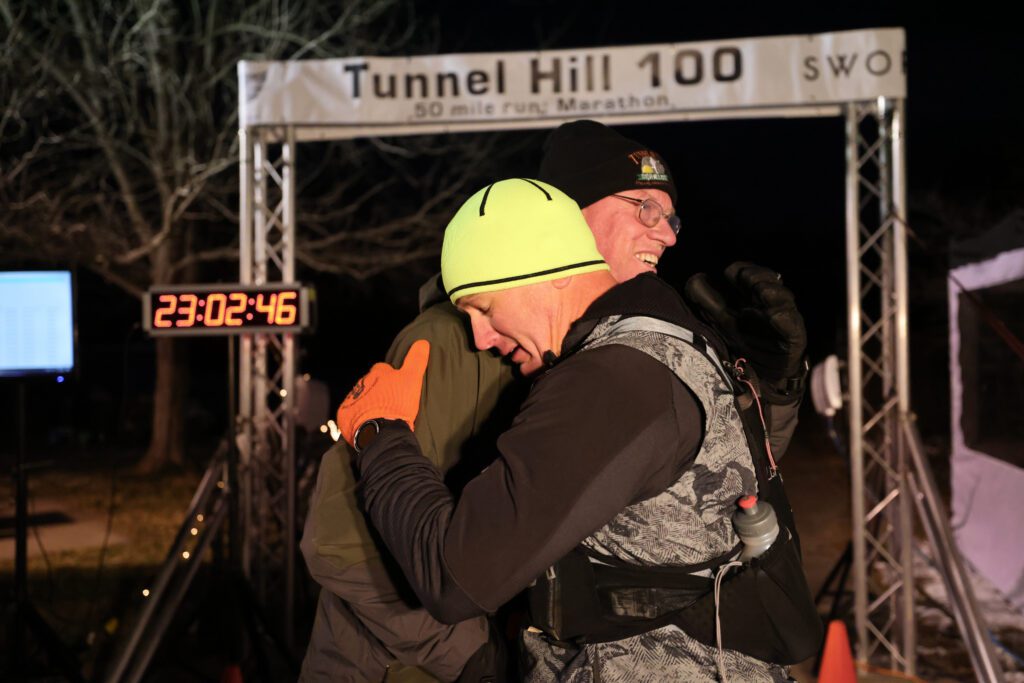
When Camille returned in 2022, was her intention to set a new world record?
Camille and Conor attend Tunnel Hill most years as our guests. Camille has served as the guest speaker and greeter twice, and Conor was the guest speaker this year. Conor closely monitors Camille’s workouts, and her results were at record-setting levels. They actually didn’t make the decision for her to go for the 50-mile world record until after she ran a training run on the course when she got to Vienna. I’m convinced that she would have broken Ann Trason’s world record of 5:40 for 50 miles. She was in phenomenal shape. Rested, and ready to go. The only thing that would threaten her attempt would be a weather change. We all monitored the forecast as it changed day-by-day, from temps in the 50s to down in the 20s. Then, the day before, they mentioned there was the slight chance of a “light dusting” of snow. From 2am until about 6am on race day we received about 3 inches. Ugh. Think about setting a world record…it’s all about training and timing. Conditioning and conditions need to be at or near perfect levels. Camille checked out the conditions on the trail, and the concern was possible freezing on the many trestles, so she made the understandable decision to not race. We all hated it, but it was the right call. She’s a great friend, and spent the day as she always does, encouraging runners on the trail, and at the finish area. People love her at Tunnel Hill.
You’ve seen some incredible performances at Tunnel Hill. What memory from the race sticks with you most?
It’s hard to beat seeing a world record. For someone who never dreamed of seeing someone set a world record—especially in southern Illinois, in a small town like Vienna—the excitement of it was incredible. Camille had been so vocal about it. The local news and regional tv station kept checking in during the race. We were taking video and sending it to them, and they did updates throughout the day. Keep in mind that Camille had never even finished a 100-mile race at the time, and I believe, failed in her two previous attempts that year. One of the things I love about Tunnel Hill is that you see the runners at the start/finish area four times; just after a marathon, the 50-mile mark, 76.5 miles, and then at the finish; is in the dark. When Camille blew through 50 miles in 6:07, we were just shaking our heads in wonder. She was way ahead of record pace, and she continued to be as the day went on. All good through the southern turnaround, and back through Vienna at 76.5. She hit the tunnel in great shape timewise. We were so nervous at the finish line. It was now dark, and runners completing 50 miles were coming through in a steady stream. We didn’t want to miss her finish, so we sent someone out about 300 yards to give us a heads up. He was nervous. The timers were nervous. We kept thinking, “Don’t screw this up!” About one hundred people were gathered along the finish, at the finish line, and when we saw her headlamp zooming towards us, in what we knew was a new world record, it was so thrilling. Ultrarunning legend Harvey Lewis ran the 50 miler and stuck around for the historic finish. He recorded a really cool video of the finish and spoke with Camille immediately afterwards (You can watch the video here: https://youtu.be/zQ_P9ml0bGk). It’s hard to say something was more memorable than that. But have you ever heard of Strolling Jim 40-mile run, founded and directed by Lazarus Lake? My good friend David Jones has won that race about a million times, especially the Masters. He also won Badwater back in the day, so that tells you just how good he was. David ran Tunnel Hill in 2016 in 17:34, and he beat the age group record—which was, I think, sixty-five to sixty-nine—by over four hours. However, it wasn’t going to be accepted because the course wasn’t certified. I said, “We have to get it certified. I am not going to have a friend of mine, or anyone, set an American record only for it not to count.” So, when that happened to David, that’s what prompted me to get the course certified. And that led to Camille setting the world record and everything else. Otherwise, she may have never checked into running the race. Isn’t that wild?
Photos: Chad Colson (@chadcolson) and Micki Beth Colson (@mother_runner_micki)
“After that race, my running began to evolve. I bought some lifestyle shoes from Target and joined a running group that met on Thursday nights. One thing led to another.”
Last October, John ran the Fancy Nonsense 50k, which is where I first encountered him. He ran the entire race ahead of me, which—as the course had an out-and-back portion—meant that, on multiple occasions, John passed me heading in the opposite direction. Something about him struck me immediately. He was encouraging and kind, his stride light and buoyant. But, moreover, John exuded joy. Pure, unencumbered joy. He genuinely looked to be having fun. “You’re out there for a long time,” says John. “The only way to get through that kind of suffering is to find joy in the moment.”
Finding joy is important to John these days. It wasn’t so long ago he couldn’t find joy in much of anything.
In 2020, with the onset of COVID, John experienced heartbreak and loss that affected him deeply. He stopped running, retreated inward, and began experiencing debilitating bouts of depression and anxiety. Here, John talks about that loss, his mental health journey, and how running has helped him cope and move forward.
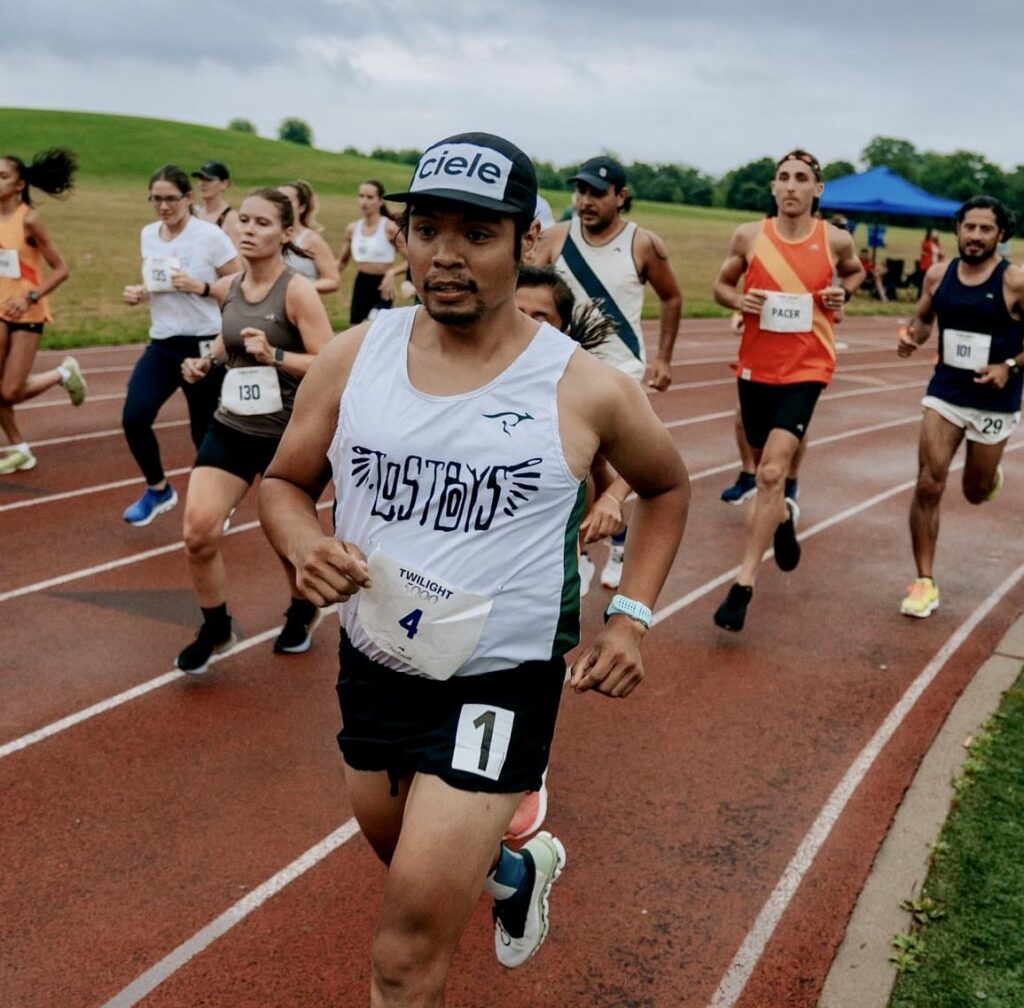
What was 2020 like for you?
It was a weird 2020 for me. Come around April, my dad ended up in the hospital. He had emphysema but ended up passing away from COVID. I don’t know how he got it. He caught it while he was recovering. Then my cat of fifteen years died. I had brought my cat to the vet for a check-up because something was wrong. They told us to leave her. We couldn’t stay because of COVID. So we dropped her off and were told to come back in an hour. Not an hour later, I got a call—something had ruptured in her stomach. We had to either take her to the ER—where she had a small chance of surviving—or put her down. So we put her down. That’s when the depression came along. And with that, anxiety. Running wasn’t even in the picture. I didn’t run at all during COVID.
Was 2020 the first time you recall experiencing depression and anxiety?
Yeah. With my anxiety, there were a lot of things that I didn’t know how to handle. Like panic attacks—I thought I was dying at one point. It’s a suffocating feeling, like you can’t breathe. The first time was very scary. It happened after my mom called me. She was crying, saying that my dad was in the hospital. It was before he died. I hung up with her and—yeah—my first panic attack happened. I had never felt that feeling before. I felt like I was chocking, like, “Oh, my God, I can’t breathe.” Also, it’s crazy, now that we’re on the topic of my mental health, before all that with my mom calling, I was at work and a customer told me that I had to come upstairs to deliver his food because he had tested positive for COVID. At that time, everything was unknown and brand new. I was like, “No, I’m not coming upstairs.” The guy insisted, saying he’d already tipped me. This is your job, he said. In a professional way, I told him that I didn’t feel comfortable doing that. I said I would leave the food with the security guard downstairs. I mean, it was a five-dollar tip. Give me a break, I didn’t want to get sick over a five-dollar tip. There’s no way. Anyway, after that happened, I felt a warm sensation in my chest. I hadn’t experienced anything like it before. I was like, “Oh, my God. What’s going on?” It was very unsettling, and I didn’t know what it was at the time. I do now though.
When did you start running again?
When 2021 came around, I started running again little by little. My friend suggested I go out for a run, that it might clear my head. One run led to another, and I kept it consistent. I didn’t race at all; I just ran for fun. I was doing it to keep sane and keep my mental health in check. This year, though, I raced my heart out. I raced the Shamrock Shuffle, the Twilight Series, and the Mob Mile. Then I did the Fancy Nonsense 50k, which is a trail run. Something about road racing just wasn’t appealing to me anymore. I didn’t find joy in running on the road. I wanted to do something I thought would test my limits. I wanted to do something more than just road races.

Where did you train for the trail run?
I have this loop that I do. I run from my house to Horner Park—which isn’t that far—and there are some side trails in that park. I do one lap there. Then, on the other side of the river, there is another trail that’s kind of in a neighborhood. I put those two together and I just do laps, over and over again, until I feel exhausted. During training, I do laps for like ten miles. It kind of mimics the race. I have to make the best of what I have in front of me.
Has running helped you work through your feelings of depression and anxiety?
Yeah, and that’s why I run a lot. It helps me stay levelheaded. It allows me to be present. I know that everything’s going to be okay. When I run, I feel free. All those feelings that I have that lead to my anxiety just kind of go away. A lot has happened over the last three years, and running was always there. It was the only option I felt I had. I don’t have a car. I don’t have the ability to go out in the middle of the woods. This is where I live, in the city. Running was my only option to stay present and know that everything was going to be okay. With running, everyone suffers in some kind of way. But in the end, it’s all okay. I look at my panic attacks that way as well. Just take a deep breath, it’ll be fine. Running saved me, in a way.
What’s next for you?
Now that I’ve done a 50k, I don’t want to run anything less. That’s not to say that I won’t, but right now I have a fire building in me to go further. I want to see how far I can push myself. I am registered for Ice Age in May, and in October I want to do the Hudson River 50 in New York City, where I am originally from. But there’s always that thing in my head: If I do a 50-miler, will I want to do a 100-miler? I don’t know. But I do wonder. And I will continue to work on my mental health, too. I’ll remember to breathe, knowing that in the end everything will be okay.
Edited for length and clarity.
Photos: Christian Rasmussen @christian_rasmussen_photo
Photos by Tim Roberts
A long plywood enclosure, narrow as a railcar, sits vacant along the curb. Empty tables are spread out over the sidewalk. Dead leaves and wilted corn husks linger among hay bales left over from the fall. Just west of the square, the L cuts a brilliant fluorescent diagonal over Jarvis Avenue—the concrete underbelly of the tracks piercingly well-lit. With her back to the open flames of a nearby fire table, Christy Chiappone stands amidst a growing number of friends and neighbors who have gathered outside the tavern for a group run through neighborhood. By 6 o’clock, more than a dozen people have shown up—a good turnout, even for a Thursday night.
The Rogers Park Running Club (RPRC) has come a long way from humble beginnings.
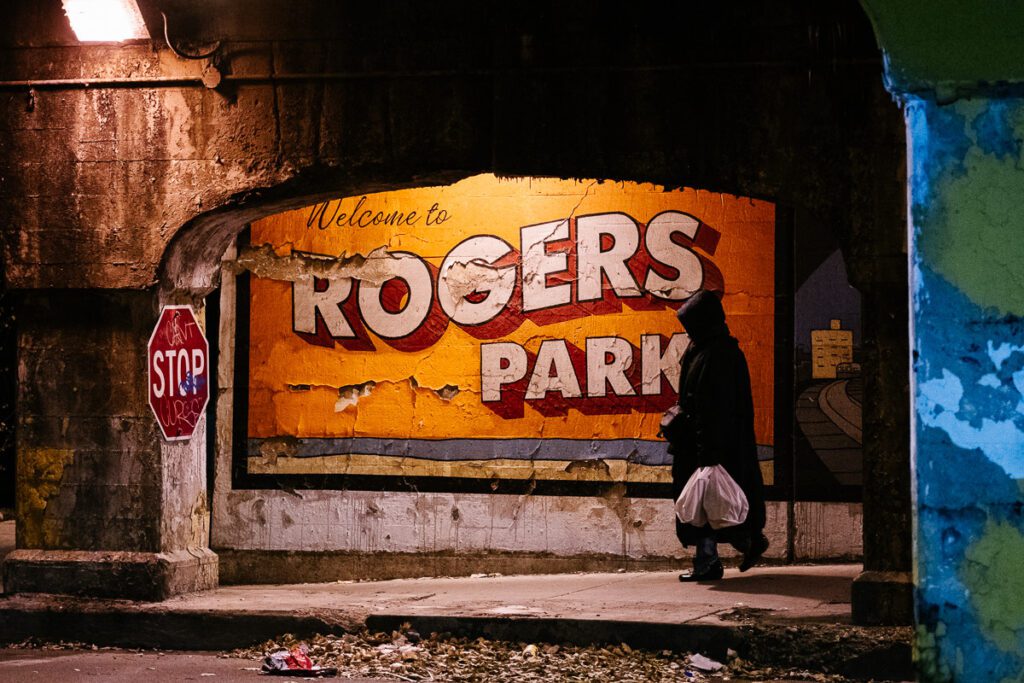
Christy—an ultrarunner and mortician by trade—moved to Chicago in 1995, eventually settling in Rogers Park in 2003. Six years later, she and another woman began running together after meeting in a neighborhood chat group. “We started running one day a week,” says Christy. “Then it slowly became two days, three days, four days, whatever.” Eventually another woman joined them, and for the next several years they ran as a trio, often rising before daybreak to run the quiet streets of Rogers Park before work. Over time, aided by consistency and a persistent social media presence, their numbers grew. “On Facebook, we have over 900 members,” says Christy. “In reality, however, maybe thirty people regularly join us for group runs.”
Here, Christy speaks with Hard Prairie about the diversity flourishing in Rogers Park, RPRC’s visibility in the community, and a little run they like to call the “Samosa Stumble.”
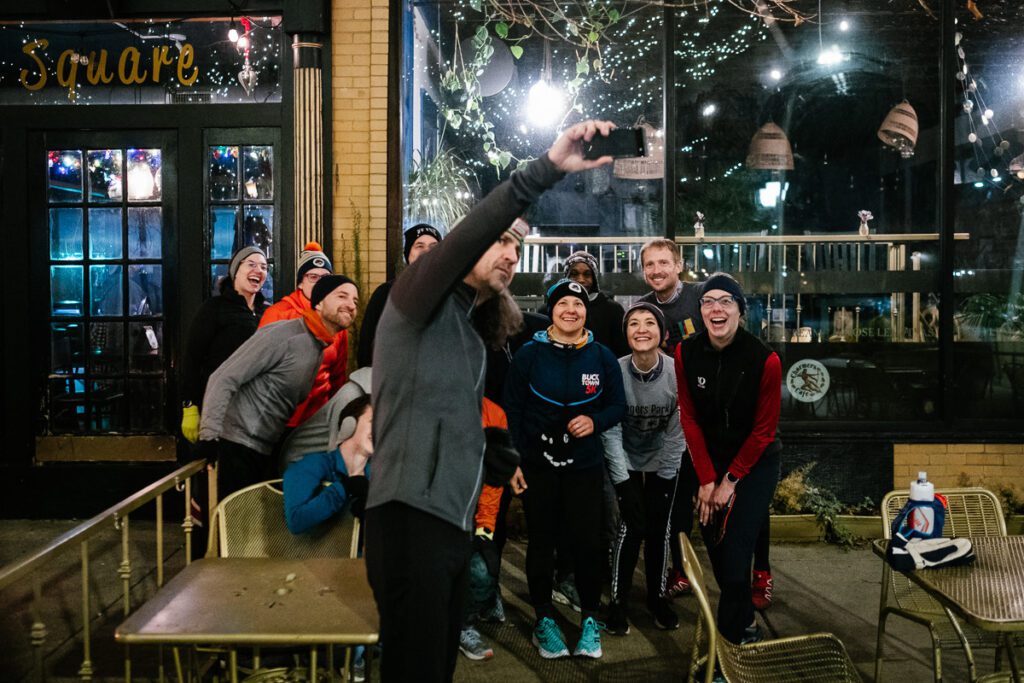
Tell me about Rogers Park.
Rogers Park is literally one of the most diverse neighborhoods in the country. There is probably seventy languages spoken here. Chicago is broken up into fifty wards, and we’re at the very north end of the city. Our northern border is Evanston. We’re right by the lake. The homes are really huge and they’re on really big lots. But there’s a lot of apartments too. There’s a lot of immigrants and refugees settling in Rogers Park. Refuge One and Heartland Alliance do a lot of their settling here, so we have a lot of African immigrants in the community. That brings with it different restaurants and grocery stores, different fashions. It’s a melting pot. Rogers Park really thrives on its ability to stay community oriented. There’s not a lot of segregation in our neighborhood. I think the majority of it is either Hispanic or African. Loyola University is in our ward as well and it’s pretty diverse. There’s a lot of activity. A lot of kids and parks. Our alderman is super involved in making the community welcoming. It has always been the activist center of the city. When Barack Obama announced his Senate candidacy, he did it here in Rogers Park.
What makes Rogers Park a good place to run?
We’re so close to the lakefront. The whole eastern border of the ward is the lake, from Devon up to Howard. That’s two miles of straight lakefront property. Then there’s Warren Park which is a little further west. They have a sledding hill there. We have two 5k fun-runs that we sponsor in Warren Park. And we also do a “Samosa Stumble.” It’s like a beer mile, only you have to eat a samosa and run a mile in twenty minutes. It’s so much fun. But even with the lakefront, if you want to stay just on that property, you don’t have to cross any streets if you go into Evanston. That’s really easy to do and very inviting. Everybody loves to run on the lakefront. We like to run our ward outline too, which is like six-and-a-half miles. But I think the lakefront is probably everybody’s favorite thing to do.

Are there things RPCP is doing to be visible in the community?
Our alderman’s wife approached us this year asking if we would do a monthly run in the north part of Rogers Park—north of Howard—where there is a lot of gang activity. She is a runner as well. It’s the last Sunday of every month. We call it the “Heart of Rogers Park Run” because the shape of the route is a heart. It’s like a two-mile route. It’s at 8 o’clock in the morning. We all wear our shirts and go run a couple loops. The idea is to let the community know that it’s okay to come out. Let’s be visible and be invested in this part of the neighborhood as well. We have also talked about maybe having other community organizations become involved as well, maybe as sponsors or a group that would be willing to bring out water or donuts after a run or something. So we try to do stuff that way. When we do ward clean-ups, we’ll make sure to have our shirts on and stuff like that. It’s not anything real hardcore. They do The Mile of Murals, and we were active in that. I think next year, we’ll do a fun-run around that—like maybe a 5k—to raise some money for it. There’s also a couple food pantries that have done 5ks and reached out to us. We try to do as much as we can.

The RPCP Facebook Group is very diverse and very active. Why do you think that is?
During the pandemic we started posting challenges so that people would stay engaged. You know, take a picture of this or that, and with every picture you’d get your name in a drawing . Then every week we’d draw a name for a $25 gift card to a restaurant in the neighborhood. This was partially to keep people involved and partially to give money to restaurants because they were hurting, and nobody knew what the hell was going on. Also if somebody was hurting due to the pandemic, we could at least give them dinner. So we’d do bingo with pictures, especially around the holidays. We just tried to keep people involved so that they would have something to do. You could always go outside and run. And it really worked. Some of the people who post today don’t even come to the runs. They never come, but they post their runs all the time. And a lot of it is because they started posting with the raffles and the challenges that we were doing. I think that makes other people feel like, “Oh, these people are posting about their stuff, so maybe my stuff isn’t that lame.” I don’t have a lock on posting, that’s open. Anybody can post. My only rule is that it has to be about running. People might post some other shit and I’ll always take it down and tell them, “Sorry, not here.” As long as it’s about running or anything remotely about running, I’m fine with it. And everybody is very supportive of everyone else. It’s valuable to them, which is why everyone keeps doing it.

The club has lasted over thirteen years, why do you think that is?
I think it’s the community aspect and just finding your people. Everybody is so nice. There hasn’t been one person I’ve had to kick off Facebook because they’ve been a dick or something. Everybody is super cool and it’s indicative of the neighborhood. I think it’s the sense of community that it brings and how welcoming it is. It is always, “Welcome! Come join us!” Literally, we will yell at people that are running around who aren’t with us: “Rogers Park Running Group, you know we’re here. Come on!”
Does that work? Have you really found new members that way?
Yeah, totally! We’re very open. There’s no fee. We don’t have liability insurance or a board or anything like that. It’s straight-up community friends, that’s it.
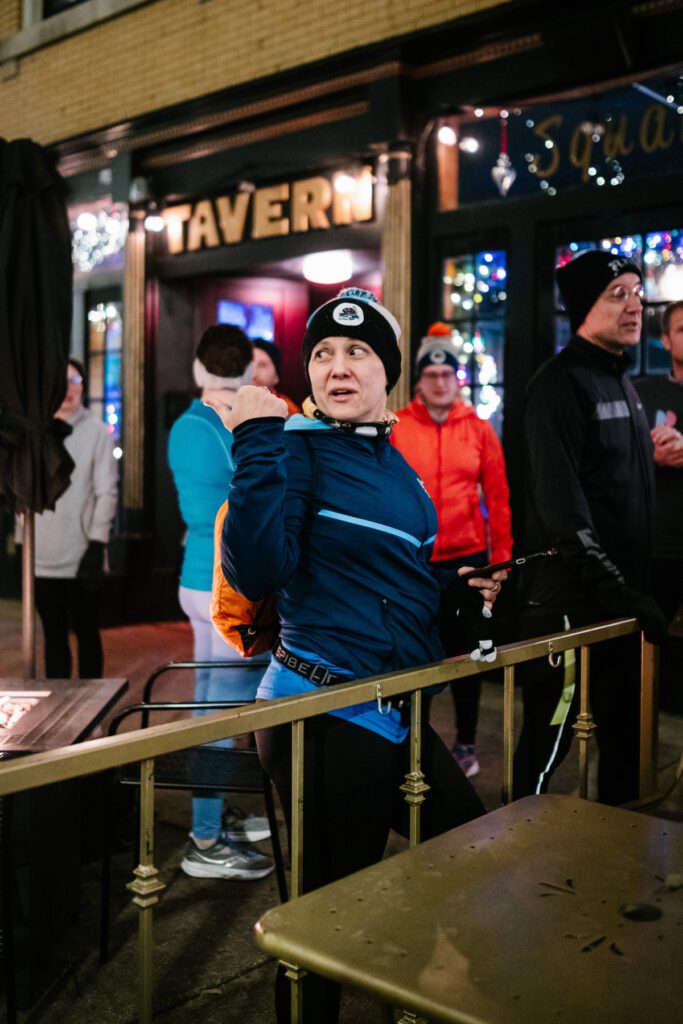
Trying to describe who Aneta (“Nettie”) Zeppettella is in a brief introduction is like trying to wrestle Athena back into Zeus’ skull. It isn’t going to happen. Nettie is simply too fierce, too irreducible. Her UltraSignup page is filled with one mind-bendingly hellish race after another: Badwater, Cruel Jewel, HURT, Fat Dog, and Hellbender. Seventy-four races in all, and—get this!—not a single DNF.
Incredible, right?
Nettie wears many hats too. Bucket hats. Kea Peak. Boco. Mother. Wife. Trail Sister. She, along with Jennifer Russo, is the co-owner and Race Director of Empower Ultras, which hosts an awesome array of trail and ultra-events throughout southwest Ohio. If that weren’t enough, Nettie is also the subject of an upcoming documentary directed by Jessica Vandenbush of Eat Clean, Run Dirty Magazine, produced with a grant from Fuji Film.
In 2021, racked by hallucinations and poor weather, Nettie became just the second woman to finish Illinois’ notorious Potawatomi 200*. Here she describes her harrowing experience, offering insight and explaining why her memory of this race has been impossible to shake.
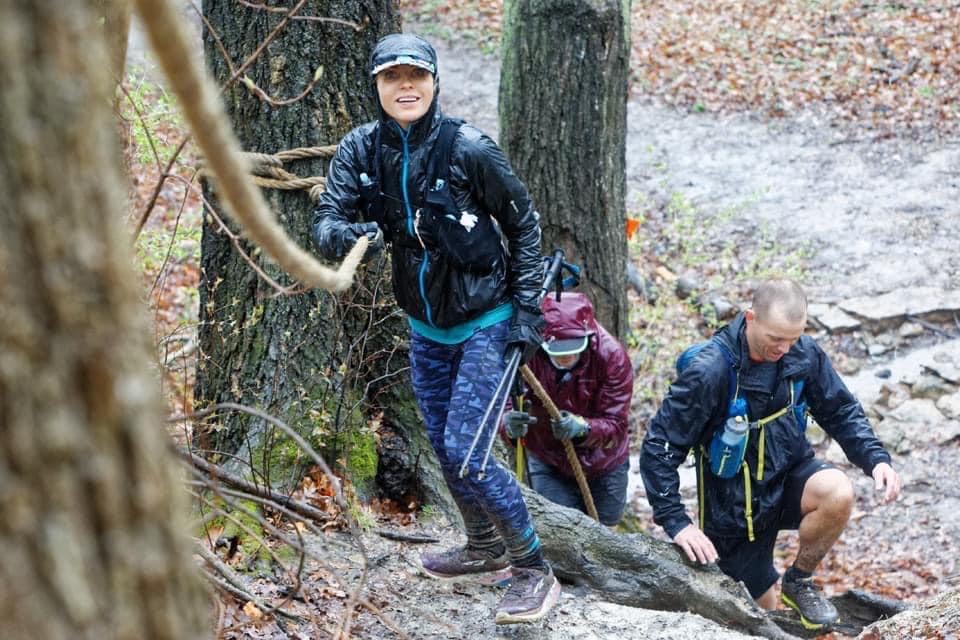
As someone who lives in Ohio, how were you made aware of Potawatomi and what compelled you to sign up?
There were a few people from Ohio who did the race before me, so I was aware of it through friends. I wanted to run a 200-mile race; however, I didn’t have time to fly out west and I didn’t want to invest too much money into it either. So, it was ideal. I could do it by myself. My friend was going to come on Saturday, but you never know if they’re going to make it. Something else might come up. Plus, it was only a five-hour drive from where I live. Registration was like $150. And the course is full of loops. I could sleep in a hotel afterwards and drive home. It was mostly logistics, and it was affordable. I had heard it was hard and the cut-off was tight, but I was willing to try because it was easy to get to mostly.
What were the weather conditions like, and did you ever consider DNFing?
It was awful. It rained nearly the whole time. The trails were turning into rivers. I was just soaked. I had three rain jackets that were all supposed to be waterproof, and they were all soaking through. I was putting extra clothes on trying to stay warm. But I didn’t really think about quitting. If I quit, I knew I’d have to come back, and I didn’t want to come back. So as long as I wasn’t going to time-out, I would keep going. I didn’t ever want to see that trail again. I wanted to get it done and over with.
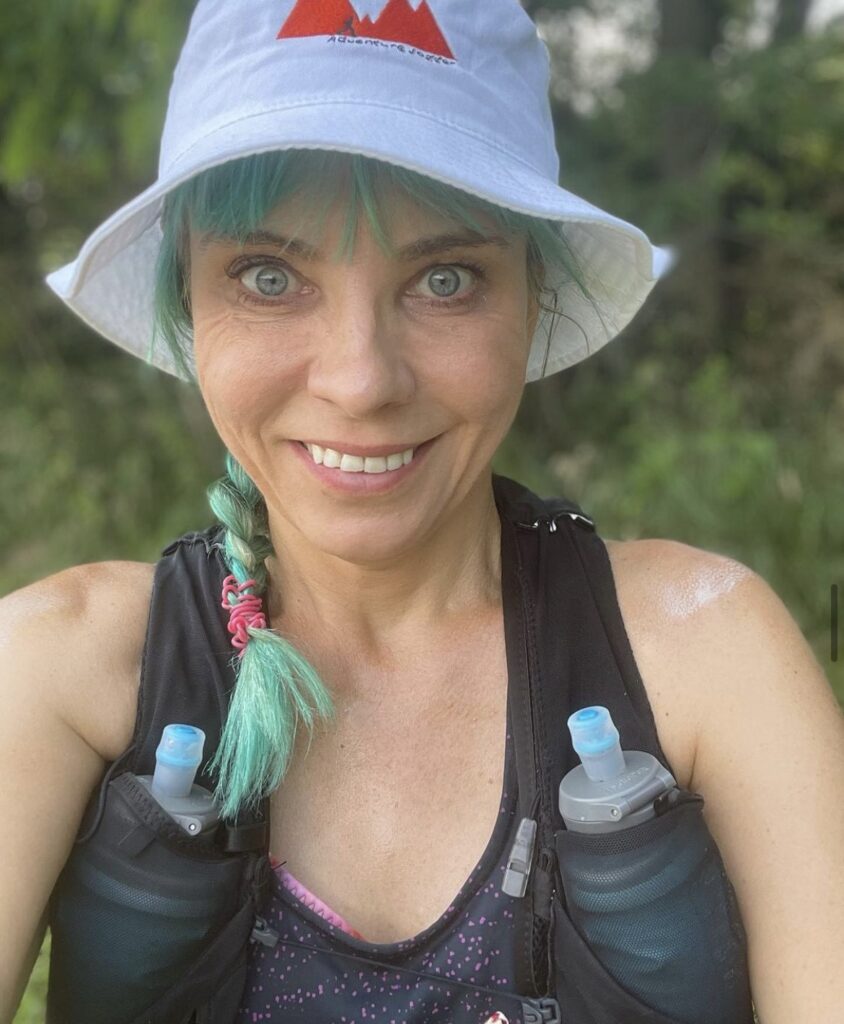
How were you able you keep from mentally spiraling out?
I hallucinated like crazy, and I was aware of it too. At some point, I had such vivid hallucinations that I was talking to someone who wasn’t there. I hallucinated a whole conversation. I became very afraid that I would hallucinate a trail marking and wander somewhere totally off-course. I was touching the trees and touching the ribbons just to make sure they were real. I kept trying to open my eyes wider. Sometimes if you blink a few times things disappear. That was the first time I ever had auditory hallucinations. I heard a theatre performance and that really scared me. When my friends came Saturday afternoon, I didn’t recognize them. I had no clue who was there and what was going on. As I was running with my friend Ruth, I kept asking if we were on the trail and if she was touching the markers. She had to remind me that she slept the day before and didn’t have to touch something to be sure it was there. She kept saying, “You can trust me.” But I was always wondering why she wasn’t touching the ribbons. So it was kind of funny. But when I was talking to that person in my head, that lady who I thought was running next to me was all of the sudden sitting inside a shoe box. It was like, poof! I was in the middle of a field and there was nobody. I was by myself. And I was like, “Okay, this is getting weird.”
You’ve completed some of the hardest races in ultra-running, yet you say that Potawatomi still haunts you. Why?
It was hard. You just keep going in a circle, and every loop gets worse. It’s raining. Then it’s raining more. The things that were easy become harder. You’re tired and the mud is getting worse. Being on that loop eighteen or nineteen times, there isn’t much to look forward to. I remember being so frickin’ annoyed because you can hear the aid station at the end of the loop from a half-mile out. You have to zigzag to it. It was fine for the first two days. But on the third day, it was really pissing me off. It was mentally draining. There was no joy in it near the end. I just wanted it done. I couldn’t look at rain either after that. I just couldn’t look at it. During the last two loops, I had to slide downhill on my butt because I was so sleep deprived. When I moved my head, it felt like I had vertigo. My head didn’t adjust to the sleep deprivation. So when I was going downhill, things were spinning. I was afraid I would topple forward, so I just slid on my butt.
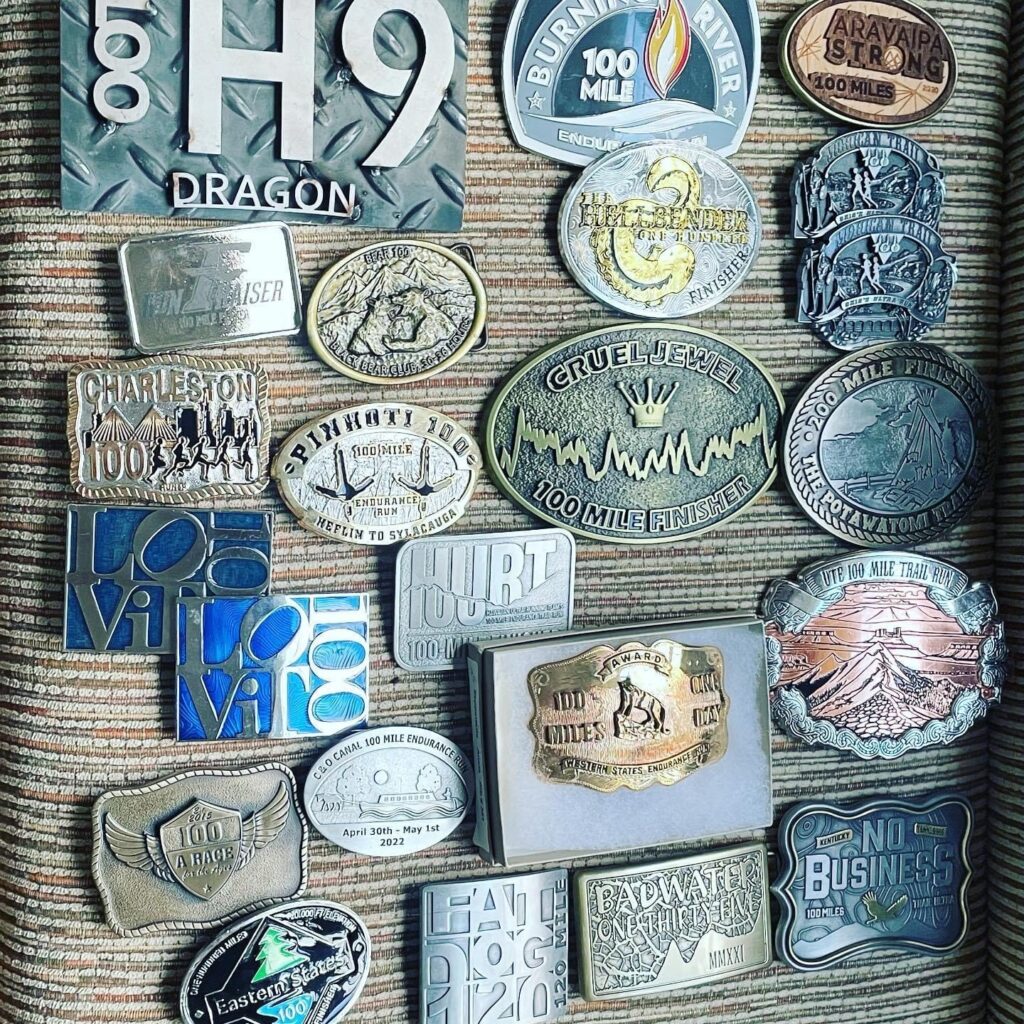
What advice do you have for a woman who might be gearing up for next year’s 200-miler?
Give the course your full respect. It’s a hard race. Running loops is easy logistically, but daunting. The weather is also bad. When I think about Potawatomi, you have to really want it. If you really want it, you can push through and get it. It’s not a race with stunning views. There are pretty places, but you will see them twenty times. I’m average talent-wise. I’m a mid-pack runner. But I think it’s very attainable. And the people there were wonderful to me. They want you to finish. I got great support from aid stations and volunteers, so the community will be there for you. Also, don’t start too fast. The year I ran, I think fourteen or fifteen ladies started the race. Many of them were way better runners than me, but some went out too fast and others just got bored. One lady had her leg lock up on her, so you also have to be lucky. I was lucky nothing horrible happened to me. I really wanted it, you know, but some of it was just pure darn luck.
*In 2022, Rachel Burke became the third female finisher on the Potawatomi 200.
This interview has been edited for length and clarity.
Photos provided by Aneta Zeppettella.